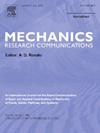Static response and solving shear-locking issue of FG plate via refined meshless method and three-dimensional estimation functions based on Reddy's HSDT
IF 1.9
4区 工程技术
Q3 MECHANICS
引用次数: 0
Abstract
This paper introduces a novel application of the element-free Galerkin (EFG) technique for addressing the static bending behavior of thick power-law and exponential-law functionally graded plates (P-FGPs and E-FGPs). The main features of this approach include the elimination of predefined mesh requirements, high adaptability to real-world models, accuracy in stress calculation, and compliance with the C1 continuity requirements of the displacement field. The approximate effects of thickness stretching are captured by the higher-order shear deformation theory (HSDT). Additionally, this study introduces a technique to eliminate the shear-locking phenomenon through specific shape functions. The anisotropic mechanical properties, including Young's modulus and Poisson's ratio, exhibit continuous variation throughout the thickness of the dual-phase metal-ceramic membrane following power-law and exponential distributions.
Moreover, this study proposes an innovative approach for estimating the central deflection of FGPs by employing the EFG method and sigmoid-cubic functions, introduced here as a novel contribution to the literature. This novel estimation function achieves excellent curve fitting, establishing itself as a highly efficient and robust solution for analyzing complex static bending behaviors of thick FG plates.
求助全文
约1分钟内获得全文
求助全文
来源期刊
CiteScore
4.10
自引率
4.20%
发文量
114
审稿时长
9 months
期刊介绍:
Mechanics Research Communications publishes, as rapidly as possible, peer-reviewed manuscripts of high standards but restricted length. It aims to provide:
• a fast means of communication
• an exchange of ideas among workers in mechanics
• an effective method of bringing new results quickly to the public
• an informal vehicle for the discussion
• of ideas that may still be in the formative stages
The field of Mechanics will be understood to encompass the behavior of continua, fluids, solids, particles and their mixtures. Submissions must contain a strong, novel contribution to the field of mechanics, and ideally should be focused on current issues in the field involving theoretical, experimental and/or applied research, preferably within the broad expertise encompassed by the Board of Associate Editors. Deviations from these areas should be discussed in advance with the Editor-in-Chief.

 求助内容:
求助内容: 应助结果提醒方式:
应助结果提醒方式:


